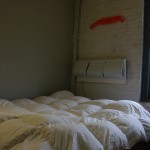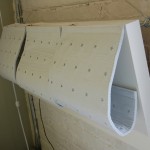swedishDawn
SwedishDawn is a bed headboard that simulates dawn by gradually increasing luminosity over time strictly mapped to a geo-located sunrise timetable. The incrementally increasing light tethers the user to the natural dawn of wherever they lay to sleep and re-establishes natural circadian rhythms. SwedishDawn is designed to to be a minimally intrusive aesthetic intervention against the maladies of subsyndromal S.A.D.
Seasonal Affective Disorder is a mood disorder that affects people during the winter season. Depressive symptoms include sleeping too much, a lethargic lack of energy and an increased desire for sweets and starch based foods. SAD is a serious disorder that requires professional attention, but also includes a subsyndromal variant that may affect 14% of the US population, approximately 49 million people.
Background
The fade is controlled by an arduino microcontroller simulating a “sigmoidal”-shaped dawn. 1 The sigmoidal function simulates the natural dawn, beginning with a gradual slope, followed by a steeper slope from about 5:00 AM to 5:30 AM, and then a gradual slope. For a bit more technical information, read here.
A common treatment for SAD is the use of a sunlamp, a specially designed fluorescent lamp, many times brighter than normal indoor lighting. This kind of light treatment has proven to be effective at doses of 2500 – 10,000 lux, a luminosity unit that takes into account the size of a room. With a sunlamp, the user sits in close proximity to the lamp between 30-60 minutes once a day. A different type of light treatment is dawn simulation, where a lamp of considerably lower overall intensity is gradually increased during the twilight in the user’s bedroom.
Dawn simulation is based on lab research done at Columbia University in the 1980s that showed animals’ circadian rhythms as sensitive to the gradual rising light of dawn. At least one study, conducted in 2001 shows a better response to dawn simulation than a regular sunlamp 2.Artificial light, intercontinental travel, 60 work weeks, have all contributed to mass disruption of human natural circadian rhythms that affect both our day to day energy and our moods.
- The equation is y = 259.5/(1+7862.5e^(-0.1358x)) where y is the illuminance in lux and x is the time in minutes after sunrise begins. ↩
- Avery, D H; Eder DN, Bolte MA, Hellekson CJ, Dunner DL, Vitiello MV, Prinz PN (2001). “Dawn simulation and bright light in the treatment of SAD: a controlled study”. Biological Psychiatry 50 (3): 205–216. doi:10.1016/S0006-3223(01)01200-8. PMID 11513820 ↩



